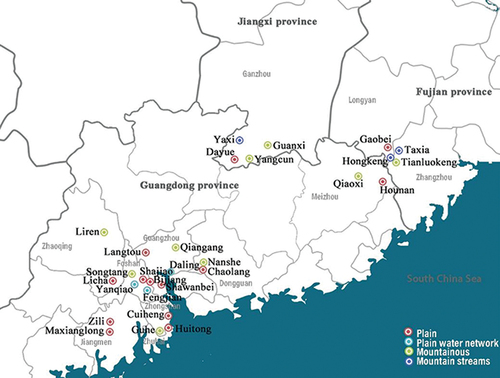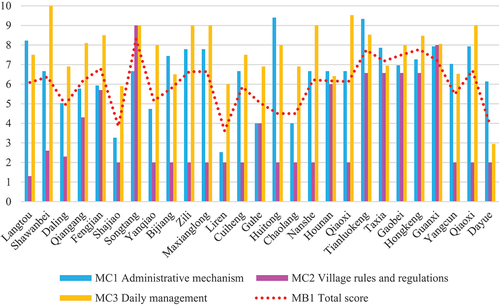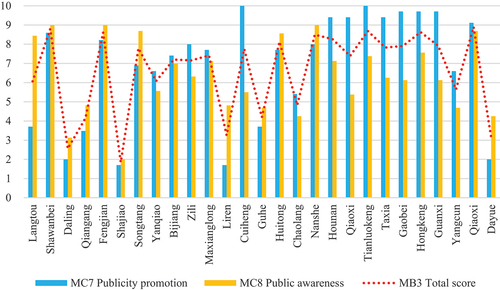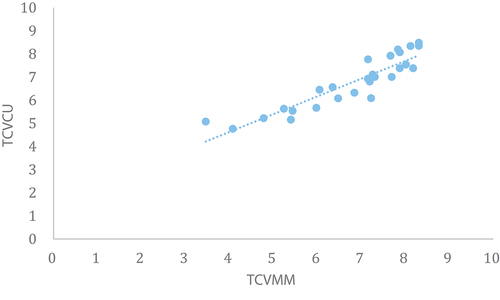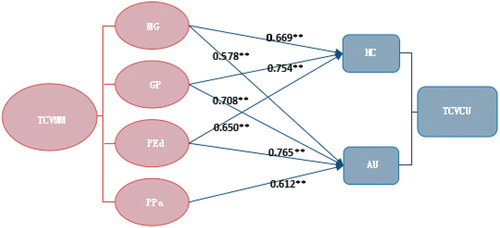 ?Mathematical formulae have been encoded as MathML and are displayed in this HTML version using MathJax in order to improve their display. Uncheck the box to turn MathJax off. This feature requires Javascript. Click on a formula to zoom.
?Mathematical formulae have been encoded as MathML and are displayed in this HTML version using MathJax in order to improve their display. Uncheck the box to turn MathJax off. This feature requires Javascript. Click on a formula to zoom.ABSTRACT
Most historic villages in China are currently emphasizing conservation over utilization, paying close attention to planning above management. Management is often deficient or poorly implemented. After conducting questionnaires and interviews with relevant experts in village management, the analytic hierarchy process was used to determine factor priority, and a system for evaluating the management mechanisms of traditional Chinese villages was established. This system includes four first-level factors: management guidance, guarantee policy, publicity and education and public participation. Twenty-seven typical traditional villages in China’s Fujian, Guangdong and Jiangxi Provinces were included in the analysis of conservation and utilization factors and the management mechanisms of traditional villages. Through field research, data on the quantitative evaluation of the management mechanisms and the performance of conservation and utilization were obtained. Two sets of data were used for correlation analysis. A strong correlation was confirmed between the conservation and utilization performance and the management mechanism of traditional Chinese villages. The corresponding factors were also revealed. A summary is provided of the problems and their causes related to conservation and utilization as implemented in the traditional Chinese villages studied herein, and optimization strategies are proposed.
GRAPHICAL ABSTRACT
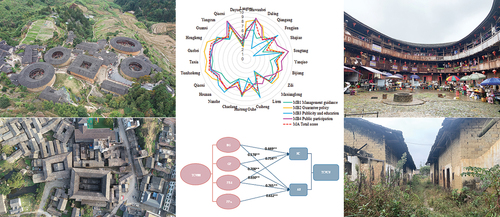
1. Introduction
China’s Ministries of Housing and Urban-Rural Development, Culture, and Finance released the first list of traditional Chinese villages in 2012. By 2021, 6,819 state-level traditional villages had been listed. Since 2014, China’s Ministries of Cultural Heritage, Agriculture, Land, and Resources and Tourism Administration have joined in the conservation work, and a policy has been established that specifies the guidelines, identification system, financial support, publicity, education, supervision and management of traditional Chinese villages.
However, several scholars have presented problems with the management mechanisms of such villages. Kong pointed out that most traditional villages emphasize conservation over utilization, paying close attention to planning above management (Kong Citation2017). Zhang Citation2020 proposed that the causes of the problems of traditional villages were urban expansion and a lack of management mechanisms (Zhang Citation2020). Liu et al. Citation2018 found insufficient implementation of management measures in traditional villages to be influenced by external forces and biased decision-making (Liu, Su, and Zhang Citation2018).
Studies of the village management mechanisms in various countries have investigated the completeness of policies, management methods, rural governance models and public participation. Chen and Jin proposed that a legal system for the conservation of traditional Chinese villages had been initially formed but lacked a complete top-level system (Chen and Jin Citation2017). Kuai proposed that the conservation system of traditional villages had insufficient systematic coordination; furthermore, only partial conservation was performed in some cases, and the overdevelopment of traditional villages also remained unsolved (Yanli Citation2016). Li and Shen pointed out contradictions between conservation policies and other policies and a lack of conservation funds (Wangming and Yinyi Citation2010). Kim discussed the impact of world heritage site designation on the development of historical villages, citing Hahao Village as an example (Kim Citation2016). Li and Chen proposed that a systematic and complete management mechanism was required in the value innovation of historical resources in traditional villages, and the multi-governance mode had an effective impact on the conservation and development of villages where there was participation by the government, market, social organizations and villagers (Lejin Citation2014). Huang et al. proposed management measures for the improvement of conservation performance, which included four aspects: environment, planning, architecture and folk customs (Huang, Li, and Xiao Citation2021). Guo and Sun analyzed the changes in traditional villages from independence to dependence on local government interventions, citing Dangjia Village, Shaanxi, as an example (Guo and Sun Citation2016). Cano et al. proposed that the cataloging and promotion of rural architecture would contribute to creating jobs by stimulating new economic activity (Cano, Garzon, and Sanchez-Soto Citation2013). Lee proposed that utilizing a zoning system could control the height and scale of buildings and conserve unique urban fabric at the human scale (Lee Citation2014). Xu and Wan discussed the rural governance model, in which outsiders transfer control to rural elites (Jin and Tao Citation2017). Park and Sohyun analyzed the institutionalization of the participatory planning mode for the conservation and management of historic villages in Korea (Park Citation2011). Kang et al. proposed that a reasonable conservation plan for Yangdong Village should be expanded to include the social connection of villagers instead of solely concentrating on historical architecture and cultural properties (Kang, Kim, and Park Citation2011). Walters explained the influence of community history and rural development on the degree of villagers’ public participation (Walters et al. Citation1999).
In summary, most studies evaluating conservation and utilization in traditional villages have examined conservation plans and their performance, but they have given scant attention to the management mechanisms of traditional villages. In addition, a small number of papers have provided case studies on the effects of particular management strategies on the performance of conservation and utilization in traditional Chinese villages (TCVCU). However, the existing management theory based on qualitative empirical theory cannot help village managers make accurate diagnoses and optimize action plans. Therefore, it is necessary to study the performance of traditional village conservation and management mechanisms comprehensively, and to explore the deep interaction and quantitative relationship between them. After conducting questionnaires and interviews with relevant experts in village management, factor priority was determined via the analytic hierarchy process (AHP), evaluation standards were established and a system for evaluating the management mechanisms of traditional Chinese villages (MMTCV) was constructed. Twenty-seven typical traditional villages in China’s Fujian, Guangdong and Jiangxi Provinces were investigated. Through field research, the villages’ management mechanisms were quantitatively evaluated and their conservation and utilization performances were determined. Two sets of data were used for correlation analysis. A strong correlation between the performance of TCVCU and TCVMM was found. By revealing the correlation mechanism between them, the factors corresponding to this strong correlation were determined. A summary is then provided of the problems and their causes related to conservation and utilization as implemented in the traditional Chinese villages studied herein, and optimization strategies are also proposed.
2. Methods
2.1. Cases
Twenty-five state-level traditional villages and two province-level traditional villages were selected as the evaluation samples. These villages are located in the Guangfu Cultural District of central Guangdong Province and the Hakka Cultural District at the border of Fujian, Guangdong and Jiangxi Provinces. The Guangfu area has a developed economy, and the Hakka region is divided between several administrative provinces. These conditions are conducive to comparing the management mechanisms among regions and villages with different economic conditions but in similar geographical locations. The 27 villages are distributed across 11 cities of 3 provinces and have different landforms, and their management mechanisms are representative. maps the geographic distribution of the villages. shows the aerial views of six representative villages. provides an overview of all of the sample villages.
Figure 2. A. Aerial view of Qiangang (50% of traditional buildings have collapsed). b. Aerial view of Nanshe (traditional buildings are well protected and utilized). c. Aerial view of Tianluokeng (traditional buildings are well protected and utilized). d. Aerial view of Taxia (traditional buildings were all protected and utilized). e. Aerial view of Yaxi (traditional buildings are well protected and utilized). f. Aerial view of Yangcun (some traditional buildings are in danger of collapse).
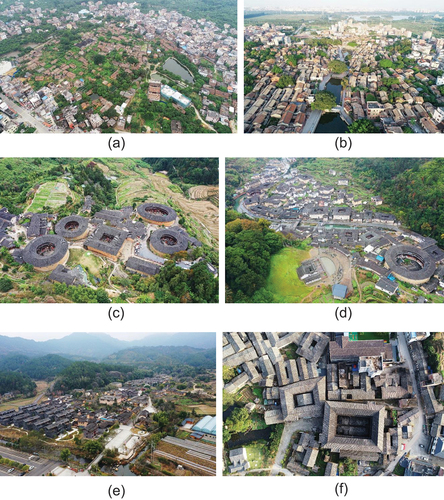
Table 1. Overview of the sample villages.
2.2. Index determination
Referring to “China’s Assessment System for the Conservation of Famous Historical and Cultural Cities,” “Evaluation Index System of Chinese Historical and Cultural Towns” and “Evaluation and Recognition System for Chinese Traditional Villages,” multisubject evaluation content was added to the factor set, considering the activities of the government, management enterprises, public welfare institutions and villagers. Via a questionnaire, in-depth interview and case study, a system for evaluating the management mechanism of TCVCU was summarized into 4 first-level factors, 10 second-level factors and 24 third-level factors ().
Table 2. TCVMM evaluation system.
2.3. Analytic hierarchy process and priority determination
Questionnaire surveys and in-depth interviews with managers from the sample villages were conducted between September and December 2020. Fourteen questionnaires were issued, 14 valid questionnaires were retrieved and priorities were obtained using the AHP. lists the TCVMM evaluation system.
The performance evaluation system of TCVCU proposed by the research group in 2021 was adopted (Huang, Li, and Xiao Citation2021) ().
Table 3. TCVCU evaluation system.
2.4. Determination of evaluation criteria
A combination of qualitative and quantitative methods was used to determine the evaluation criteria. Examples of quantifiable factors included government financial appropriation and the amount of private funds. For unquantifiable factors, such as the integrity and flexibility of village rules and regulations, qualitative methods were adopted for classification. Using a 10-point scale, the factors were divided into five grades: excellent (10–9), good (8–7), average (6–5), below average (4–3) and poor (2–0).
Through on-site investigation, information on village landscape patterns, surrounding environments, building conservation status, village conservation documents, inheritance situation of intangible cultural heritages, village rules and regulations and other topics was collected. The staff of village committees and conservation institutions were interviewed to understand the local conservation situations, management modes, funding and technical guarantees, publicity and educational means and public participation of the traditional villages. Interviews and questionnaire surveys were carried out to understand the living situations and traditional customs of the local people and to capture the villagers’ attitudes toward the conservation and development of their villages and their satisfaction with the conservation effect and management subjects.
2.5. Comprehensive evaluation, reliability analysis and correlation analysis
Scores of B and C layer factors and total scores per village were obtained using the multi-objective linear weighted function method (EquationFormula 1):
where M is the total score of the comprehensive evaluation, is the score of a single index j,
is the priority of a single index j at its level and
is the priority of the i factor at the first level.
Scoring was conducted according to the scoring criteria. Cronbach reliability analysis was used to analyze the scoring data of TCVMM and TCVCU (EquationFormula 2):
where is the reliability coefficient,
is the number of evaluation factors,
is the internal variance of the score in the i-th question and
is the variance of the total score of the factors.
Formula 3 was used to analyze the correlation between TCVMM and TCVCU (EquationFormula 3):
where Cov(X,Y) is the covariance of X and Y, Var[X] is the variance of X and Var[Y] is the variance of Y.
3. Results
3.1. Evaluation results
3.1.1. Comprehensive evaluation
shows the evaluation scores for TCVMM. The overall performance of the management mechanism of the sample villages was normally distributed. Five villages, namely Shawanbei, Tianluokeng, Hongkeng, Songtang and Yaxi, scored above 8.0 points, accounting for 19%; 15 villages scored more than 6.0 and less than 8.0 points, accounting for 56%; and 7 villages scored less than 6.0 points, accounting for 26%. The villages with the highest scores were Shawanbei and Tianluokeng, with a score of 8.31 points. Daiyue scored the lowest, with 3.46 points.
Figure 3. (a). All 27 villages’ TCVMM evaluation scores. (b). All 27 villages’ TCVCU evaluation scores.
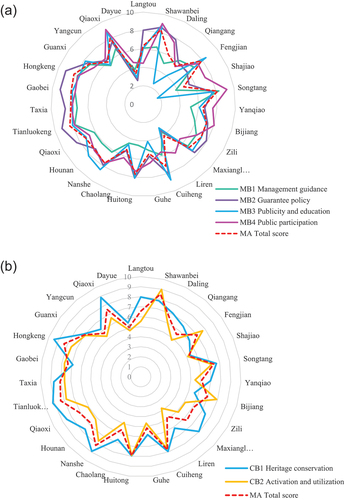
shows the results of the evaluation of TCVCU. Five villages, namely Shawanbei, Tianluokeng, Hongkeng, Nanshe and Taxia, scored above 8.0 points, accounting for 19%; the highest total score was 8.49 points, achieved by Shawanbei. Eight villages, namely Fengjian, Songtang, Cuiheng, Huitong, Qiaoxi, Gaobei, Gangxi and Yaxi, scored more than 7.0 and less than 8.0 points, accounting for 30%. Liren Village scored the lowest, with 4.76 points. The remaining 13 villages scored more than 5.0 and less than 7.0 points, accounting for 48%.
3.1.2. Analysis of two performance evaluations
3.1.2.1. Analysis of the TCVMM evaluation
Shawanbei, Tianluokeng, Hongkeng, Songtang and Yaxi achieved excellent scores. The management mechanisms of these traditional villages are almost perfect, and each has at least one particularly prominent factor. For example, village governance in Songtang is promoted through village rules and regulations. In contrast, Daiyue, Huitong and Liren performed the worst. The first two of these are province-level traditional villages, while Liren was only designated a nation-level traditional village in 2019. This indicates that nation-level traditional villages by definition have received more resource investment. Qiangang and Shajiao demonstrated poor performance on MG and PEd, which explains their poor conservation situation.
(1) Management guidance
In terms of management guidance, Songtang, Tianluokeng and Guangxi scored highest, whereas Shajiao, Liren and Daiyue scored lowest ().
In terms of administrative mechanism, Langtou, Huitong and Tianluokeng scored highest. These villages typically have been awarded multiple titles, such as traditional Chinese villages, famous Chinese historical and cultural villages, cultural relics conservation units, characteristic towns or star scenic spots. Each title has its own set of relevant planning guidelines for conservation and utilization.
Most of the traditional villages had not formulated a conservation and management system and could not adhere to the conservation plan to guide the conservation work. A few of the villages had formulated management measures, but could not implement them due to the incoordination between the management measures and the villagers’ demands. For example, if the owners of the traditional residential houses in Bijiang Village moved out, they would be compensated for a maximum of 80 m2 of the houses’ land area. However, as the land areas of most traditional buildings exceed the 80 m2 stipulated by the government, the villagers are unwilling to sell. Not only are the villagers reluctant to move out, but they cannot apply for government funds to maintain the residential buildings. Therefore, it is common for them to use low-cost techniques when conducting repairs on these buildings or add extensions to the buildings. As another example, the villagers of Daiyue spontaneously raised funds to repair the partially collapsed enclosed houses, but they were required to stop because the repair process and technology did not meet the standards of the management methods. Furthermore, the government was unable to allocate enough conservation funds. As a result, the conservation work of the enclosed houses stagnated, and thus they may experience natural damage over time.
(2) Guarantee policy
A guarantee policy refers to the village managers guarantee funds to the village, technology and supervision in the process of the conservation and development of traditional villages. Shawanbei, Tianluokeng, Hongkeng and Huitong scored high, and Liren scored the lowest (). Guarantee policies are related to the location and economic development of the city to which a village belongs. Shawanbei and Huitong are both located in relatively economically developed cities, and the government financial guarantee is relatively generous. World heritage sites, such as Tianluokeng and Hongkeng, have special policies for capital and technical guarantees.
(3) Publicity and education
Publicity and education mainly includes two aspects. One is to publicize and promote traditional villages through online platforms, newspapers, publications and radio. The other is to educate villagers and other social groups about the value and cultures of traditional villages and to improve their awareness of conservation. Shawanbei, Fengjian, Cuiheng, Tianluokeng, Guangxi and Yaxi demonstrated good publicity and promotion implementation (). They have diverse target audiences for publicity, including the government, tourism companies, media, merchants, tourists and villagers, and various online and offline publicity media. Some of the villages publicize and promote village culture by participating in and organizing activities and competitions related to traditional culture or art. For example, Huitong has increased its popularity by actively participating in provincial and municipal competitions and artistic festivals. In particular, the University Town Art Festival has attracted many tourists.
(4) Public participation
In terms of public participation, Songtang and Yaxi had the highest score, whereas Daiyue had the lowest (). The villagers of Songtang have the best awareness of village conservation planning. At present, the main channels of public participation include the villagers’ meeting, the villagers’ congress, the affairs bulletin board and message board of the village committee government, a WeChat group, household investigation, community workshops and local organizations’ or groups’ participation in management. Currently, the villagers’ congress is the most commonly used channel. Creating a joint community model to encourage villagers to participate in the actual work of environmental transformation has been attempted in Bijiang and Fengjian. The village committee of Songtang encourages villagers to actively participate in village conservation affairs, including applying for the title of famous village and the formulation of village regulations and regulations.
3.1.2.2. Analysis of the TCVCU evaluation
In terms of resource conservation, Hongkeng, Tianluokeng, Nanshe, Yaxi, Taxia and Qiaoxi demonstrated good performance. These villages adopt the method of overall conservation and building new villages nearby to prevent modern construction from destroying traditional features and cultural heritage, and to make it easier to carry out conservation measures.
In terms of activation and utilization, Shawanbei, Fengjia, Nanshe and Tianluokeng demonstrated good performance. These villages adopt methods such as functional renewal, integrated resources to develop tourism and multi-party construction to promote the value innovation of heritage resources in traditional villages.
3.2. Reliability analysis
The reliability value of TCVMM was 0.89 and that of TCVCU was 0.874. Both values are larger than 0.8, indicating the high reliability of the evaluation data.
3.3. Correlation analysis
3.3.1. Overall correlation analysis
shows the scatterplot of the linear regression analysis, demonstrating a strong correlation between TCVMM and TCVCU. presents the results of the linear regression analysis. The R-squared value of the model was 0.829. This indicates that TCVMM can explain 82.9% of the changes in TCVCU.
Table 4. Linear regression analysis (n = 27).
3.3.2. Correlation analysis of first-level factors
shows the correlations between the first-level factors of TCVMM and TCVCU.
Table 5. Correlation coefficients between the MC and CC layers.
illustrates the data presented in to facilitate the qualitative analysis.
Table 6. Correlation coefficients between the MD and CD layers.
MG, GP and PEd demonstrated significant positive correlations with HC. Sufficient funds, technical support and sufficient supervision and guarantees are important prerequisites for implementing resource conservation measures in traditional villages. PEd can improve the public understanding of the value of traditional villages.
MG, GP, PEd and PPa also demonstrated significant positive correlations with AU. The AU of traditional villages requires the support of capital, technology and talent. Management guidance and policies affect the consequences of implementation, and PPr promotes the development of tourism. The construction and utilization of traditional villages involves land expropriation, the use of traditional public buildings, rental of residences and other economic activities closely related to the interests of villagers, which require the participation and input of villagers.
3.3.3. Correlation analysis of second-level factors
shows the correlations between the second-level factors of TCVMM and TCVCU.
illustrates the data presented in Table 7.
Figure 10. Correlations of the second-level factors between TCVMM and TCVCU.

DM and TA were correlated with environmental factors. The guidance and supervision of experts and technicians are significant to maintaining the environment quality of traditional villages.
AM, DM, FS, TA, AS and PA were correlated with planning factors. Planning strategies and management measures stipulate the conservation content and construction control regulations that DM strictly carries out. FS and TA provide timely support, and AS provides effective control. Together, they ensure the pattern integrity, richness, original authenticity and coordination of old and new buildings in traditional villages.
AM, DM, FS, PPr and PA were significantly correlated with building factors. In contrast to planning factors, TA has little impact on building factors, and PPr is conducive to improving the public’s enthusiasm for the conservation and utilization of traditional buildings.
AM and PPr were correlated with folkways factors. The continuation of folkways lacks public motivation and mainly relies on guarantees from AMs. PPr plays a positive role in promoting the public cognition of folk culture.
VRR, EC and PEn were correlated with inheritance factors. The inheritance of folkways cannot be separated from public engagement. VRR reflects the recognition of villagers, and PA can improve public awareness.
AM, PPr, PA, PEn and PS were significantly correlated with development factors. The importance of traditional industries and infrastructure requires publicity and education to obtain support from the public, which has an obvious effect on improving public satisfaction.
AM, VRR, DM, FS, PEn and PS were significantly correlated with society factors. The integration of old villages and modern life requires the joint action of top-down and bottom-up driving forces. Publicity and education can improve the social influence of villages.
AM, DM, FS, PPr, PEn and PS were significantly correlated with economic factors. The cultural heritage of traditional villages is a good resource for developing tourism. In Shawanbei, Cuiheng, Qiaoxi and Gaobei, repairing traditional buildings, beautifying environments and improving tourism infrastructure have improved tourism quality. The popularity of traditional villages has been enhanced through various publicity channels. This has resulted in good economic benefits and increased happiness and satisfaction among the villagers.
4. Conservation and utilization problems and their causes, and management mechanism optimization measures
4.1. Conservation and utilization problems and their causes
4.1.1. Poor conservation
The landscape environment around some traditional villages has been damaged. Such damage includes the erosion of mountains and the pollution of rivers and ponds. Many traditional dwellings are uninhabited and face the risk of eventual eradication. New rooms had been build on the top floor or in the courtyard of the old house to increase the living area, and cheap materials and rough production process had been used in the construction process to save maintenance costs, which had led to uncoordinated with the traditional style. And new traditional buildings lack harmony with the older traditional style, thus destroying the overall style of the village.
Due to the imperfect upper-level system of conservation management, the management process was complex, the rights and responsibilities of the management department were unclear and it was difficult to coordinate. There were no detailed local support systems for conservation and utilization in many of the traditional villages. In some other villages, specific conservation methods had been formulated, but they were ineffective because they were not supported by law. Each traditional building must be declared separately, and in this process, insufficient financial funds and poor management efficiency can lead to delay or stagnation. The planning implementation evaluation and dynamic supervision were weak. The governance system of village rules and regulations was not ideal, and the bottom-up driving force was insufficient.
This can be explained as follows. Their national financial funds were limited, and they had difficulty paying the huge expenses solely with funds from local governments, village committees and villagers. Planning and management at the grassroots level was weak, and the professional quality of said planning and management required improvement. At the same time, the amount of technical personnel was insufficient. The traditional villages encompassed extensive areas and had heavy governance duties, leading to difficulties in planning implementation and supervision. Traditional construction skills were on the decline and were decreasingly transmitted from generation to generation.
4.1.2. Poor development
The landscape environment of villages and the development of traditional public spaces and public buildings are insufficient. Furthermore, the use efficiency of traditional buildings is low. Maintaining traditional material elements is costly, the income of cultural tourism is relatively low and the inheritance and continuation of intangible cultural heritage has little vitality.
This can be explained as follows. The management method was too rigid and was thus unable to adapt to local conditions. Publicity promotion intensity was insufficient, and the communication channels were weak, leading to poor conservation awareness among villagers. Most of the traditional villages used outdated means of publicity or were promoted weakly, leaving the public and social groups with little appreciation for the attractiveness of the villages. Public participation was insufficient to mobilize the enthusiasm of the villagers to participate in village conservation and development. The single most common means of public participation was the villagers’ congress. Most of the planning information was obscure, which greatly reduced the effectiveness and enthusiasm of the villagers to participate. The entire process of planning preparation and implementation only involved public interests and did not involve private property rights, and the villagers’ right to know and make decisions were limited.
4.2. Optimization measures of management mechanism
According to the correlation analysis between two evaluations, AM, DM, FS, PPr, PA and PEn have many important effects on conservation and utilization performance. These effects require additional attention and improvement. VRR and TA affect individual factors, and AS and PS have weak effects. Based on the performance evaluation results, management mechanism optimization measures are proposed for AM, DM, FS, PPr, PA and PEn given their important effects on conservation and utilization performance.
4.2.1. Optimization measures of management guidance
Administrative mechanism
We suggest improving the management system guarantee and determining the management regulations in detail, strengthening organizational guarantees, paying attention to the retention and training of management talents at the grassroots level and establishing a mechanism for the flow of talents and wealth between urban and rural areas. We further suggest allowing a certain degree of flexibility in the conservation and management methods of ordinary traditional buildings, implementing classified conservation methods and simplifying the declaration process.
(2) Village rules and regulations
The values and content of the conservation and development of traditional villages could be organically integrated into the village rules and regulations. The best example of this is Songtang, where the contents related to planning, construction requirements and application procedures, conservation objects, prohibited behaviors, the use of business income and rewards and punishment measures are all included in the village rules and regulations.
(3) Daily management
The daily management of cultural heritage in traditional villages could be given greater attention, and digital archives could be constructed. We suggest establishing resource conservation archives, dynamic tracking systems and information monitoring systems in traditional villages to record the changes in various information and data of villages in real time. Environmental health management and conservation systems could be improved to encourage grassroots managers’ good performance in routine inspection and maintenance.
4.2.2. Optimization measures of guarantee policy
Financial support
In traditional villages, construction projects should be reasonably planned and could be carried out as a part of overall management and construction. We suggest giving full play to the advantages of enterprises in capital management and market operation, paying attention to innovative financing mechanisms and attracting villagers to become shareholders. Flexible and diversified land management policies could be explored for the separation of “land, housing and people.” Given that the actual use area of residential houses was insufficient, we suggest appropriately expanding the per capita construction land and homestead control index under the conditions that cultivated land is not occupied and hillside land is not used.
(2) Technical assistance
We suggest strengthening the training of management skills and technical methods among competent local departments, development and management of team leaders, full-time managers and other relevant individuals. Excellent design units and construction enterprises should be encouraged to regularly dispatch engineers to guide the implementation of conservation. Referring to the practical experience of community construction in Bijiang, registered planners should be recruited from nearby areas to participate in conservation and management efforts.
4.2.3. Optimization measures of publicity and education
(3) Publicity promotion
We suggest making full use of diversified media forms, such as using a public WeChat account, TikTok, Kuaishou, Xiaohongshu and other popular social media platforms, for promotion and making comprehensive use of text, animation and short-form video to meet the needs of netizens’ aesthetic fragmentation and entertainment. Combining the multiple strengths of government, media and public welfare organizations, diverse means of publicity could be used, such as outdoor sports events, photography competitions, intangible cultural heritage experiences and custom festival displays.
(4) Educational cognition
Quality education on the conservation of traditional culture could be provided to enhance the villagers’ association of identity with village culture. Cultural activities should also be held to promote intangible cultural heritage, such as customs, festivals and dialect ballads. Learning from the British diversified publicity methods for the conservation of traditional cultural heritage, such as integrating historic and cultural heritage conservation education into primary and secondary school education, visiting historic heritage and historic villages and establishing heritage lottery funds, could also be helpful.
4.2.4. Optimization measures of public participation
We advocate for the combination of individual participation and organizational participation. Public participation should not be limited to simple methods, such as notification and perfunctory consultation. Alternative modern and multi-level methods for public meetings should be provided, including household visits, participatory workshops and online participation. The information feedback channels should be opened, and an open information sharing and feedback platform for multi-party coordination should be developed. The government should provide the necessary funds, policies and other resources to support village committees and activate the enthusiasm of grassroots mass cadres for advancing the villages. Full play should be given to the initiative of village committees, the “top-down” conservation and development plans should be combined and “bottom-up” villager feedback channels should be implemented.
5. Conclusions
The AHP was used to build the evaluation system of TCVMM and TCVCU. Twenty-seven traditional villages in Guangdong, Fujian and Jiangxi constituted the study sample. Declaration data, conservation planning and government work reports were consulted and in-depth interviews with managers and villagers were conducted to obtain the score data. A strong correlation was found between TCVMM and TCVCU. Significant positive correlations were found between first-level factors (MG, GP and PEd) and HC, as well as between first-level factors (MG, GP, PEd and PPa) and AU. Correlation analysis of second-level factors also found associations among multiple factors, such as AM, DM, FS, PPr and PA, which demonstrated great influences on more than four first-level factors of the TCVCU.
Through the feedback of two performance evaluations, problems regarding the conservation and utilization were summarized and the causes were analyzed. For six important factors (i.e., AM, DM, FS, PPr, PA and PEn) and two less important factors (i.e., VRR and TA), the corresponding optimization measures of the management mechanism were proposed. In terms of management guidance, we suggest improving top-level institutional guarantees, strengthening organizational guarantees, attaching importance to the retention and training of management talents at the grassroots level, implementing classified conservation methods and simplifying the management process. Reasonable provisions of rewards and punishments should be written in the village rules and regulations. The construction of digital archives of traditional villages should be strengthened, and infrastructure and other operating mechanisms should be improved. In terms of guarantee policies, we suggest establishing a diversified fund supply mechanism and actively creating a good policy environment. Professional and technical forces should be guaranteed, and the system of traditional village planners should be explored. In terms of publicity and education, we suggest expanding diversified communication channels, carrying out a variety of publicity activities and promoting the education of different public groups on the conservation of traditional culture. In terms of public participation, the forms thereof should be enriched, the information feedback channels should be optimized and the initiative of village committees should be improved.
The villages selected for this study are concentrated in Fujian, Guangdong and Jiangxi Provinces in southern China. Thus, to compare them with other regions in China, the commonality and variability of the analysis results and the general applicability of the conclusions need to be verified via extensive in-depth investigation. Differences between the typical regional management mechanisms will be a key point of future research. Furthermore, the innovative management mechanisms of excellent traditional villages are worthy of in-depth analysis.
Author contributions
X.D. Liu completed the data collection and analysis and wrote the first draft of the manuscript. Y. Huang proposed the original concept and methodology and modified the manuscript. H.L. Xiang participated in the investigation. C. Zhang, J. Chen and D.W. Xiao took part in the original concept discussion.
Disclosure statement
No potential conflict of interest was reported by the author(s).
Data Availability Statement
Not applicable.
Correction Statement
This article has been republished with minor changes. These changes do not impact the academic content of the article.
Additional information
Funding
Notes on contributors
Xuedong Liu
Xuedong Liu, assistant Planner, Guangzhou Urban Planning & Design Survey Research Institute, 10 Jianshe, Guangzhou, Guangdong Province, China
Yi Huang
Yi Huang, associate professor, School of Architecture, State Key Laboratory of Subtropical Building Science, South China University of Technology, 381 Wushan, Guangzhou, Guangdong Province, China
Huilin Xiang
Huilin Xiang, assistant architect, Hunan Architectural Design Institute Group Co., Ltd., 65 Fuxiang, Changsha, Hunan Province, China
Chen Zhang
Chen Zhang, doctoral student, School of Architecture, State Key Laboratory of Subtropical Building Science, South China University of Technology, 381 Wushan, Guangzhou, Guangdong Province, China
Juan Chen
Juan Chen, doctoral student, School of Architecture, State Key Laboratory of Subtropical Building Science, South China University of Technology, 381 Wushan, Guangzhou, Guangdong Province, China
Dawei Xiao
Dawei Xiao, professor, School of Architecture, State Key Laboratory of Subtropical Building Science, South China University of Technology, 381 Wushan, Guangzhou, Guangdong Province, China
References
- Cano, M., E. Garzon, and P. J. Sanchez-Soto. 2013. “Historic Preservation, GIS, & Rural Development: The Case of Almería Province, Spain.” Applied Geography 42: 34–47. doi:10.1016/j.apgeog.2013.04.014.
- Chen, C., and L. Jin.2017.“The Difficulties and Prospect of the Traditional Village’ Protection and Utilization in Liaoling Province[J].” Shanghai Urban Planning Review 137(6): 59–63. In Chinese.
- Guo, Z., and L. Sun. 2016. “The Planning, Development and Management of Tourism: The Case of Dangjia, an Ancient Village in China[J].” Tourism Management 56: 52–62. doi:10.1016/j.tourman.2016.03.017.
- Huang, Y., E. Li, and D. Xiao. 2021. “Conservation Key Points and Management Strategies of Historic Villages: 10 Cases in the Guangzhou and Foshan Area, Guangdong Province, China[J].” Journal of Asian Architecture and Building Engineering 1–12. doi:10.1080/13467581.2021.1966016.
- Jin, X., and W. Tao. 2017. “Outsiders-to-Rural Elites-Based Rural Governance Model: A Case of Village, H Province[J].”City Planning Review 41 (12) 65–72. In Chinese
- Kang, D., M. Kim, and M. Park. 2011. “A Settlement Pattern and Consciousness Change of Yangdong Village Connected with institutionalization[J].” The Journal of Korea Planners Association 46 (5): 93–111.
- Kim, S. 2016. “World Heritage Site Designation Impacts on A Historic Village: A Case Study on Residents’ Perceptions of Hahoe Village (Korea)[j].” Sustainability 8 (3): 258. doi:10.3390/su8030258.
- Kong, W. 2017, March 15 “The Conservation of Traditional Villages Should Be Planned and remanaged[N].” China Art News 6. In Chinese
- Lee, S. J. 2014. “A Study of Management Measures and Methods for the Conservation of Historic and Cultural Characteristics of Greenwich Village in New York[J].” Journal of the Architectural Institute of Korea Planning & Design 30 (12): 225–234. doi:10.5659/JAIK_PD.2014.30.12.225.
- Lejin, L.2014.“Chen. Zhiyong. Research on the System Innovation of the Diversified Governance Mode of Ethnic Villages and towns[J].” Social Sciences in Guangxi 323(10): 68–74. In Chinese.
- Liu, L., D. Su, and Y. Zhang.2018.“Empirical Research on Management Measures of Conservation Plan of Traditional Village[J].” Development of Small Cities & Towns 40(6): 76–81. In Chinese.
- Park, S. 2011. “Institutional Approach to Collaborative Conservation and Management Planning for Historic Villages - Based on Policy Analysis of Local Ordinance for Hahoe Yangdong Conservation Councils[J].” Journal of the Architectural Institute of Korea Planning & Design 27 (3): 241–252.
- Walters, B., A. Cadelina, A. Cardano, and E. Visitacion, et al. 1999. “Community History and Rural Development: Why Some Farmers Participate More Readily than others[J].” Agricultural Systems 59 (2): 193–214. DOI:10.1016/S0308-521X(99)00003-7.
- Wangming, L., and S. Yinyi. 2010. “Improving the Feasibility and Effectiveness of Urban-Rural Planning Evaluation[J].”Planners 26 (3) 19–24. In Chinese
- Yanli, K.2016.“Research on Traditional Village’s Protection System in China[J].” Modern Urban Research 1: 2–9. In Chinese.
- Zhang, J. 2020. “Exploration on the Strategies of the Traditional Villages’ Protection and Development under the Background of Construction of Beautiful Countryside[J].”Urban Development Studies 27 (8) 37–43. In Chinese

